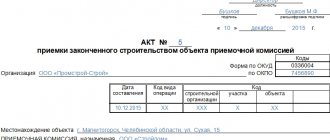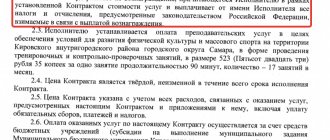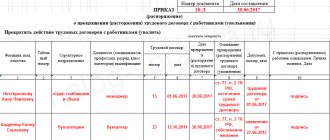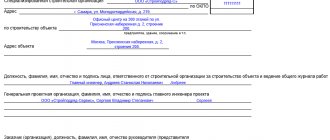In this article we will look at: form KS-11 (Acceptance certificate for a completed construction facility). Let's find out how to fill out the form and understand the step-by-step instructions for filling it out.
All construction organizations draw up certain documentation at different stages of work. For this purpose, many reporting forms have been developed that allow you to document business events correctly. In particular, the transfer of a completed construction project must be supported by an act in the KS-11 form.
What is the KS-11 form?
The acceptance certificate for a completed construction facility is used to reflect in the accounting of the facility in respect of which all the necessary construction and installation works have been completed or reconstruction has been carried out. The form is unified by the provisions of the State Statistics Committee and has the approved form OKUD 0322003.
You can familiarize yourself with the KS-11 form.
Important! This document must be drawn up by the customer after the condition of the object has been checked and the results of all measurements have been taken into account, since it is the test results that represent the main information reflected in the report.
Act KS-14. 3 page
The last page of the KS-14 act should contain information about installed equipment, utility networks, and even landscaping and landscaping of the territory. As shown in Figure 3, Form 14 includes a separate table to reflect landscaping data. It needs to specify such indicators as types of work, their volume, unit of measurement and deadlines.
The final stage of filling out the sample form KS-14 will be to indicate information about the total cost of the estimate documentation, divided into the cost of construction and installation work and the cost of equipment. Further information on the as-built technical documentation and additional conditions are indicated. The KS-14 act is approved by the signatures of all responsible persons and the acceptance committee.
Figure 3. Table for filling out data on landscaping in the KS-14 act
Typical mistakes when filling out Form KS-11
The formation of the document may be accompanied by errors on the part of the person responsible for filling out the KS-11 act. Let's look at the violations that occur most often in practice.
| P/n | Errors when filling out the KS-11 act | |
| Violation | Elimination method | |
| 1 | There was an error in one of the cells intended for a numerical indicator | From a theoretical point of view, corrections can be made to the document. To do this, it is enough to use the general rules for correcting documents, crossing out the incorrect entry and indicating the correct one. However, in practice, if a violation is identified, it will be more rational to prepare the document again. |
| 2 | The act in form KS-11 is not signed by one of the parties | Due to the fact that this document serves as the basis for notifying the statistical office about the completion of construction, filling out all mandatory details is a mandatory requirement for the performing company |
| 3 | For a construction project belonging to the category of non-residential buildings, the table “Option B”, intended for residential premises, has been filled out. | When drawing up a document, you need to pay attention to the tables. Depending on what kind of object is built, it is necessary to determine which of the tables must be filled out. In this case, there is no need to fill out the second table. |
Filling procedure
To correctly fill out the KS 11 form, you must adhere to the following rules:
- In the header of the document you must indicate:
— serial number of the act (if available); — name and date of preparation of the document; — name and main codes of the compiling organization (necessary for maintaining the company’s financial statements, including paying taxes); — Full name of representatives of the customer and the contractor of construction work;
- the name of the constructed/reconstructed property and the address of its location;
- data from related organizations, which:
— a permit for the construction of the specified property has been issued; — design documentation was developed; — design and estimate documents were approved; — the initial data necessary for the construction of the property has been provided; — other work has been completed (subcontracting companies);
- start and completion dates of construction and installation work and equipment installation;
- indicators of the constructed structure:
- if construction/reconstruction of a premises is carried out that is not intended for permanent residence of people, then option A is filled in, in which it is necessary to indicate such indicators as (if any): - power; — productivity; - length; — area of production premises; — capacity; — throughput; - volume; — the number of jobs provided, and so on; - if a building belonging to the housing stock has been built or has undergone major repairs, then option B is filled in and the following parameters are indicated (if any): - total area of the building; — number of floors in the building; - volume of construction, including underground floor; - area of extensions; - the number and area of apartments equipped in the house;
- For any buildings, additional characteristics must be indicated, which relate to such aspects as:
— installed additional equipment; — hot and cold water supply systems; — gas supply; — sewer network; - heating system; — energy supply; - elevator; — landscaping of the local area; — laying roads and sidewalks; — equipping with outbuildings for domestic purposes; — installation of sports grounds and children's playgrounds, and so on;
- the cost of work including VAT, which is necessary to determine the tax base, including UTII;
- a list of documents that confirm all the data stated in the act (drawn up as an appendix);
- additional conditions (full acceptance of the building or acceptance of a separate part of the building provided for by the project);
- signatures of the parties.
Litigation in connection with the signing of certificates of completion of work under a construction contract
Legal regulation of the acceptance of work under a construction contract is provided for in Articles 720 of the Civil Code of the Russian Federation (general provisions on construction contracts) and 753 of the Civil Code of the Russian Federation (provisions on construction contracts).
At the same time, the mandatory drawing up of an act upon acceptance of work is provided only for a construction contract (clause 4 of Article 753 of the Civil Code of the Russian Federation). Article 720 of the Civil Code of the Russian Federation does not contain a requirement to formalize the results of acceptance under a work contract in writing. However, the certificate of completion of work can be used by the parties as written evidence in court (Article 75 of the Arbitration Procedure Code of the Russian Federation, Article 71 of the Code of Civil Procedure of the Russian Federation). In addition, drawing up a written document allows you to unambiguously record the date of acceptance of the work, which is essential for determining the moment when the risk of accidental destruction of the work passes to the customer (Article 705 of the Civil Code of the Russian Federation) and the occurrence of the customer’s obligation to pay for the work (Clause 1 of Article 711 of the Civil Code of the Russian Federation) .
A certificate of completion of work is a document signed by the customer and the contractor, which records the fact and results of acceptance of the work.
It should be borne in mind that, according to established judicial practice, the act records the contractor’s performance of his obligations under the contract and cannot be considered as a transaction within the meaning of Art. 153 Civil Code of the Russian Federation. For this reason, the act cannot be declared invalid according to the rules on the invalidity of transactions (Resolution of the FAS Volga-Vyatka District dated March 22, 2012 in case No. A4329613/2010, Resolution of the FAS Moscow District dated July 29, 2010 No. KG-A41/7506-10).
In this regard, a subsequent challenge by one of the parties to a construction contract (customer or contractor) of the certificate of work performed previously signed by the parties (for example, according to the unified forms KS-2 and KS-3) cannot be carried out according to the rules of invalidity of transactions. In this case, the customer or contractor must file claims in court, for example, for monetary recovery of the cost of work actually performed under a construction contract, for recovery of damages, for reimbursement of their expenses for eliminating defects, when the customer’s right to eliminate them is provided for in the construction contract (Article 397397 Civil Code of the Russian Federation), and others. When considering the listed and other claims, questions are raised about the discrepancy between the signed acts of work performed and the actual circumstances.
The fact that acts of completed work are not transactions also means that their preparation does not require compliance with the procedure provided for in Art. 78-79 of the Federal Law of December 26, 1995 No. 208-FZ “On Joint Stock Companies” for concluding major transactions (Resolution of the Federal Antimonopoly Service of the North-Western District of March 20, 2009 in case No. A05-3246/2008). Likewise, when drawing up an act, the rules on concluding large transactions in a limited liability company (Article 46 of the Federal Law of 02/08/1998 No. 14-FZ “On Limited Liability Companies”) and the rules for concluding interested party transactions (Article 81- 84 of the Federal Law of December 26, 1995 No. 208-FZ “On Joint-Stock Companies”, Article 45 of the Federal Law of February 8, 1998 No. 14-FZ “On Limited Liability Companies”). Let us note that the fact that the act of completed work is a transaction is denied not only in judicial practice, but also in the legal literature (Ershov O.G. Signing the act of acceptance of the result of construction work: transaction, transaction-like or actual actions? // “Law and Economics”, 2012 , No. 7).
Chapter 37 of the Civil Code of the Russian Federation does not contain requirements for the form of the work completion certificate. In paragraph 4 of Art. 753 of the Civil Code of the Russian Federation, which regulates the acceptance of work under a construction contract, only states that the delivery and acceptance of work is formalized by an act signed by both parties.
The forms of acceptance certificates for certain types of work are contained in by-laws. For example, Resolution of the State Statistics Committee dated November 11, 1999 No. 100 approved unified forms of primary accounting documentation, including forms KS-2 and KS-3 for acceptance of construction and installation work and confirmation of their cost. From January 1, 2013, the forms of primary accounting documents contained in albums of unified forms of primary accounting documentation are not mandatory for use. At the same time, forms of documents used as primary accounting documents established by authorized bodies in accordance with and on the basis of other federal laws (for example, cash documents) continue to be mandatory for use (information of the Ministry of Finance of Russia No. PZ-10/2012).
Resolution of the State Committee of the Russian Federation on Statistics dated October 30, 1997 No. 71a approved forms KS-3 “Certificate of the cost of work performed and expenses”, KS-6 “General log of work”, KS-11 “as unified forms of primary accounting documentation.” Certificate of acceptance of a completed construction facility”, KS-14 “Acceptance certificate of a completed construction facility by the acceptance committee.”
The parties may use the form determined by the head of the customer or contractor in accordance with Part 4 of Art. 9 of the Federal Law of December 6, 2011 No. 402-FZ “On Accounting”. They can also use the form of a universal transfer document recommended by the letter of the Federal Tax Service of Russia dated October 21, 2013 No. ММВ-20-3 / [email protected] And yet, in practice, when completing construction work, the most common use of the unified forms KS-2 provided for by the parties to the contract , KS-3 and KS-14. We believe that with this use, a reference to the acceptance of construction work on the basis of unified acts must necessarily be contained in the construction contract.
If during acceptance the customer finds shortcomings in the work, he has the right to indicate them in the certificate of completion of work (clause 2 of article 720 of the Civil Code of the Russian Federation). When signing the act, the customer may not have the technical ability to include information about the shortcomings of the work. This is possible if the act was prepared by the contractor and does not contain the corresponding section or in the case where the parties provided for the use of the KS-2 form established by Order of the State Statistics Committee of November 11, 1999 No. 100, which also does not provide columns for indicating deficiencies. In such a situation, the customer should refuse to sign the act indicating the reasons for the refusal (detection of deficiencies) and provide information about the deficiencies in a separate document, which, in accordance with clause 1 of Art. 720 of the Civil Code of the Russian Federation must be handed over or sent to the contractor.
In judicial practice, there are three different positions on the issue of the consequences of signing a certificate of completion of work without any comments. Thus, there is a position according to which signing a certificate of completion of work without comments may deprive the customer of the right to refer to defects in the work in the future. There is another point of view, according to which the customer in this situation is deprived of the right to refer only to obvious shortcomings. According to the third position, the presence of certificates of completed work, signed without comments, does not deprive the customer of the right to present his objections regarding the volume and quality of the work performed.
The personal practice of the author of the publication shows the validity of the contractor’s references to the signing at one time by the customer, without any comments, of acts of forms KS-2 and KS-3, the use of which was provided for by the parties to the contract. Representing the interests of the contractor, we drew the attention of the arbitration court that, according to the forensic construction examination carried out, the identified deficiencies were removable and obvious in nature and could have been detected using the usual method of acceptance. By accepting the work without inspection and signing the act, the customer subsequently deprived himself of the opportunity to refer to deficiencies that could have been identified during the inspection (obvious deficiencies), since otherwise was not established by the contract (clause 3 of Article 720 of the Civil Code of the Russian Federation). In the dispute presented here, the arbitration court recognized our arguments as justified. The customer’s claim was denied, and the court’s decision “stood” in higher courts.
For the sake of objectivity, it should be noted that the later judicial practice of the cassation instance of the Far Eastern District began to interpret the same provisions on the application of the same provisions of the law differently. Thus, in the decision of the Arbitration Court of the Far Eastern District dated September 11, 2018 No. F03-3304/2018 in case No. A73-3602/2018, the court stated the following:
“The argument of the cassation appeal about the customer’s acceptance of the work performed in the absence of comments is subject to rejection, as based on an incorrect interpretation of the norms of Article 723 of the Civil Code of the Russian Federation, since the shortcomings are obvious, since the presence of acts of work performed, signed without comments, does not deprive the customer of the right to present his objections regarding the volume and quality of work performed (paragraphs 12 and 13 of the Information Letter of the Presidium of the Supreme Arbitration Court of the Russian Federation dated January 24, 2000 No. 51 “Review of the practice of resolving disputes under construction contracts”). A similar approach is set out in the Resolution of the Presidium of the Supreme Arbitration Court of the Russian Federation dated April 22, 2014 No. 19891/13...”
Within the framework of this position, the courts, as a rule, proceed from the fact that the signing of acceptance certificates for completed work without comments in itself cannot indicate recognition by the customer of high-quality work (but we draw the attention of readers to the fact that in the above fragment of the decision of the Arbitration Court of the Far Eastern district of September 11, 2018 No. F03-3304/2018 we are talking not only about the quality, but also about the volume of work performed). And the presence of such acts, signed without comments, does not deprive him of the right to present his objections to the court regarding the quality of the work. In this case, the customer, who accepted the completed work without comments, can subsequently prove its poor quality by presenting an expert opinion. The customer’s refusal to carry it out may result in failure to prove the contractor’s improper fulfillment of his obligations.
Courts generally recognize only the certificate of completion of work as proper evidence of the contractor’s performance of work, which is why disputes often arise about its proper execution and content. Thus, according to the definition of the Supreme Arbitration Court of the Russian Federation dated August 12, 2011 No. VAS-10240/11 in case No. A41-1001/10, acts drawn up or sent after the termination of the contract are not evidence of the completion of work (in this case, the definition concerned a subcontract agreement, but the same the conclusions can be extended to general contracting agreements and other construction contracts). In another example from practice, acts that were signed outside the designated column intended for the signature of the contractor and the customer (that is, in fact, did not contain the signatures of the contractor and the customer), the court did not recognize as evidence of work completion (resolution of the Federal Antimonopoly Service of the West Siberian District dated 06/01/2009 No. F04-3006/2009 (7132-A70-44) in case No. A70-3151/6-2008).
In the event of a dispute, the certificates of completed work signed by the parties to the contract must be compared in terms of the scope and content of the work not only with the text of the construction contract and its annexes (where, as a rule, the content of construction and repair work is reflected in the specifications), but also with the texts additional agreements to the contract concluded during its execution (often numerous).
Thus, in one of the court cases, while defending the interests of the contractor, we were faced with the customer’s position, which denied both the number of bored piles installed by the contractor at the construction site, and the fact that the customer disputed the location of these piles at the site as not corresponding to the design estimates documentation. The exact number of piles at the site was determined by the forensic construction examination carried out in the case, on which we insisted and which was carried out by the arbitration court of first instance only after the judicial acts were canceled by the court of cassation. As for the location of the piles, we drew the attention of the arbitration court to the fact that their location corresponds to several design changes (there were eight in total) submitted to the contractor by the customer. So the piles stood where they needed to be, where the customer indicated they should be placed, having changed the design he had submitted.
As a result, we can draw a line under a small study of law enforcement practice and try to determine the meaning of acts of work performed under construction contracts.
These acts are characterized by the fact that they:
· are documents that record the fact and results of acceptance of work;
· record the contractor’s performance of his obligations under the contract;
· are the basis for the customer’s obligation to pay for the work;
· cannot be considered as a transaction within the meaning of Art. 153 of the Civil Code of the Russian Federation, and therefore cannot be challenged according to the rules of invalidity of transactions and do not require approval according to the rules for approving transactions;
· can be drawn up in any form chosen by the parties to the contract (the law does not contain requirements for the form of the work completion certificate);
· the reports may contain references to deficiencies discovered by the customer in the work performed by the contractor;
· are important for determining the moment of transfer to the customer of the risk of accidental loss of work;
· act in judicial practice as the appropriate and main evidence of the contractor’s performance of work.
MIKHAIL SLEPTSOV
, ATTORNEY, MANAGING PARTNER OF THE LAW OFFICE "SLEPTSOV AND PARTNERS", CANDIDATE OF LAW, ASSOCIATE PROFESSOR, HONORED LAWYER OF THE RUSSIAN FEDERATION
Source of publication: information monthly “The Right Decision” issue No. 07 (201) release date of 07/22/2019.
The article was posted on the basis of an agreement dated October 20, 2016, concluded with the founder and publisher of the information monthly “Vernoe Reshenie” LLC “.







